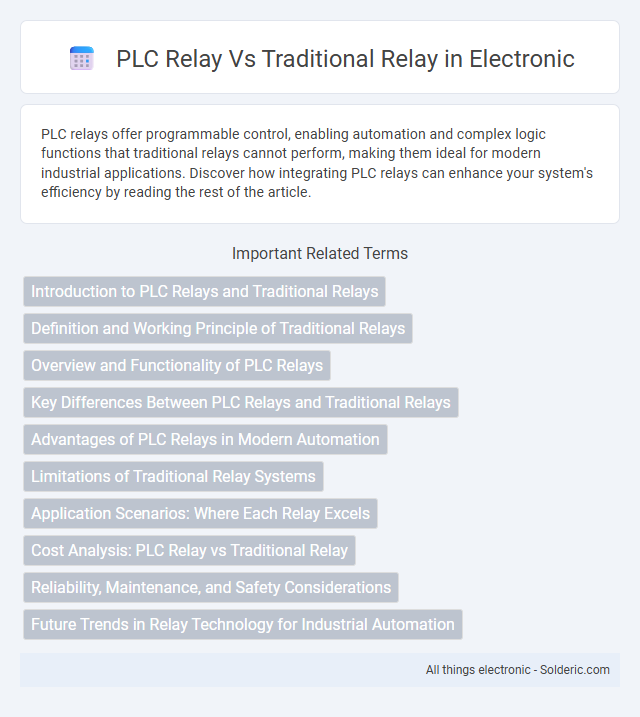PLC relays offer programmable control, enabling automation and complex logic functions that traditional relays cannot perform, making them ideal for modern industrial applications. Discover how integrating PLC relays can enhance your system's efficiency by reading the rest of the article.
Comparison Table
| Feature | PLC Relay | Traditional Relay |
|---|---|---|
| Function | Programmable control and switching | Simple ON/OFF switching |
| Control Method | Software-based logic control | Electromechanical operation |
| Flexibility | Highly flexible, supports complex automation | Limited to predefined wiring |
| Response Time | Fast and precise | Slower due to mechanical movement |
| Lifespan | Longer, minimal mechanical wear | Shorter due to mechanical contacts |
| Maintenance | Low, software updates only | High, requires mechanical inspection |
| Cost | Higher initial investment | Lower initial cost |
| Installation | Complex programming and setup | Simple wiring and installation |
| Applications | Industrial automation, complex systems | Basic switching, simple circuits |
Introduction to PLC Relays and Traditional Relays
PLC relays are designed for programmable logic controllers, enabling automated control with precise timing and programmable logic functions. Traditional relays operate as electromechanical switches that respond directly to physical inputs without programmable features. Your choice between these relays depends on the complexity and flexibility needed in your control system.
Definition and Working Principle of Traditional Relays
Traditional relays are electromechanical switches that use an electromagnet to mechanically operate a set of contacts, enabling or interrupting electrical circuits. When an electric current flows through the coil, it generates a magnetic field that pulls a lever and changes the switch contacts' position. Your control system relies on this precise mechanical movement for switching high-current loads in various applications.
Overview and Functionality of PLC Relays
PLC relays are integrated within programmable logic controllers to provide precise and automated control over industrial processes, enhancing flexibility compared to traditional electromechanical relays. Unlike traditional relays that operate through physical contacts, PLC relays utilize solid-state components to achieve faster switching speeds, reduced wear, and increased reliability in complex control systems. These relays enable seamless communication between sensors, actuators, and controllers, allowing programmable logic controllers to execute complex sequences and diagnostics with greater efficiency.
Key Differences Between PLC Relays and Traditional Relays
PLC relays offer programmable control and integration within automated systems, enabling precise timing and sequencing compared to traditional electromechanical relays, which operate on fixed switching mechanisms. Unlike traditional relays that rely on mechanical contacts for switching, PLC relays utilize solid-state components, resulting in faster response times and enhanced durability under frequent cycling. Furthermore, PLC relays provide improved diagnostics and remote monitoring capabilities, which traditional relays lack, making them more suitable for complex industrial automation environments.
Advantages of PLC Relays in Modern Automation
PLC relays offer enhanced flexibility and programmability compared to traditional relays, enabling seamless integration into complex automation systems. Their ability to handle multiple input and output signals reduces wiring complexity and increases system reliability. Advanced diagnostics and real-time monitoring features in PLC relays optimize maintenance and minimize downtime in modern industrial environments.
Limitations of Traditional Relay Systems
Traditional relay systems face limitations such as slower switching speeds, mechanical wear, and limited programmability, which reduce their efficiency in complex automation tasks. Their sensitivity to electrical noise and physical vibrations leads to frequent maintenance and decreased reliability compared to PLC relays. The lack of integration capabilities in traditional relays restricts scalability and advanced control functionalities essential for modern industrial applications.
Application Scenarios: Where Each Relay Excels
PLC relays excel in complex automation systems demanding precise control, real-time monitoring, and integration with programmable logic controllers, making them ideal for manufacturing and industrial processes. Traditional relays perform well in simple, low-cost applications such as basic switching tasks, lighting circuits, and small machinery where advanced programmability is unnecessary. Your choice depends on whether you need advanced automation capabilities or straightforward, reliable relay operation.
Cost Analysis: PLC Relay vs Traditional Relay
PLC relays generally present a higher initial investment compared to traditional relays due to advanced technology and programmability, but they offer significant long-term savings by reducing maintenance and labor costs. Traditional relays are cost-effective for simple, low-volume applications, but they lack the flexibility and scalability that PLC relays provide, which can increase expenses in complex or evolving systems. Your choice between PLC and traditional relays should consider the total cost of ownership, including installation, operation, and potential downtime impacts.
Reliability, Maintenance, and Safety Considerations
PLC relays offer enhanced reliability compared to traditional relays due to their solid-state components, which reduce mechanical wear and failure rates. Maintenance requirements for PLC relays are significantly lower, as they eliminate the need for frequent inspections and replacements typical of mechanical relay contacts. Your safety is improved with PLC relays through integrated diagnostics and faster response times, minimizing the risk of electrical faults and system malfunctions.
Future Trends in Relay Technology for Industrial Automation
PLC relays are increasingly integrated with smart sensors and IoT connectivity, enabling real-time monitoring and predictive maintenance, which surpasses the capabilities of traditional electromechanical relays. Future trends emphasize solid-state relay designs that offer higher switching speeds, enhanced durability, and reduced energy consumption, aligning with Industry 4.0 demands. Advanced PLC relay systems will incorporate AI-driven diagnostics and adaptive control to optimize industrial automation processes and minimize downtime.
PLC relay vs traditional relay Infographic

 solderic.com
solderic.com